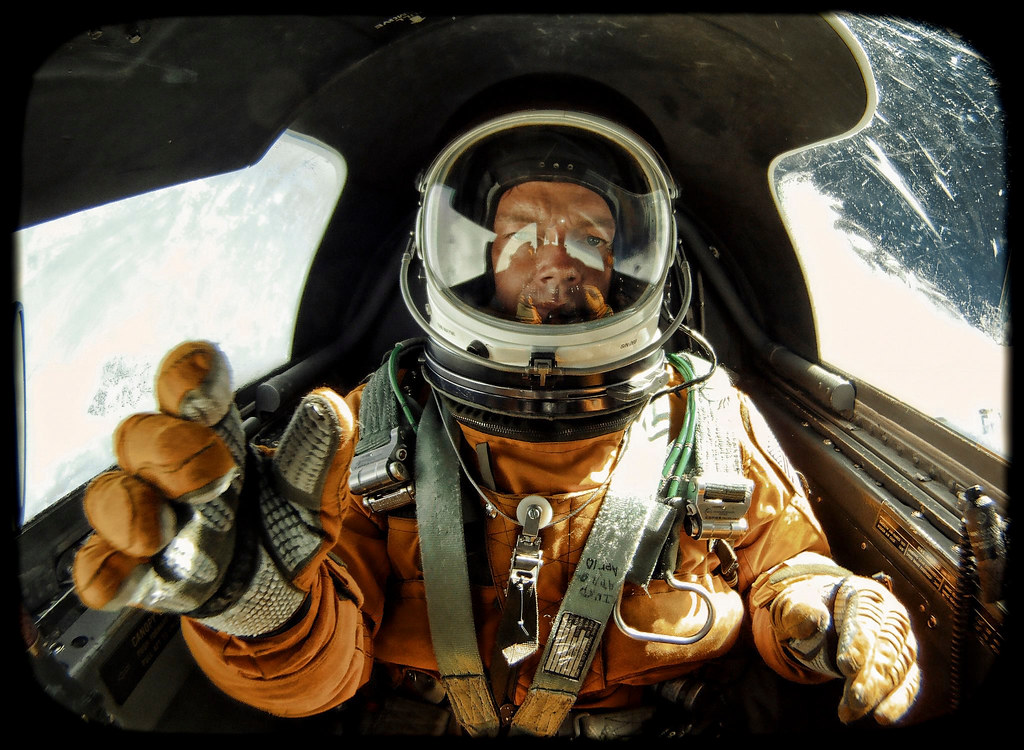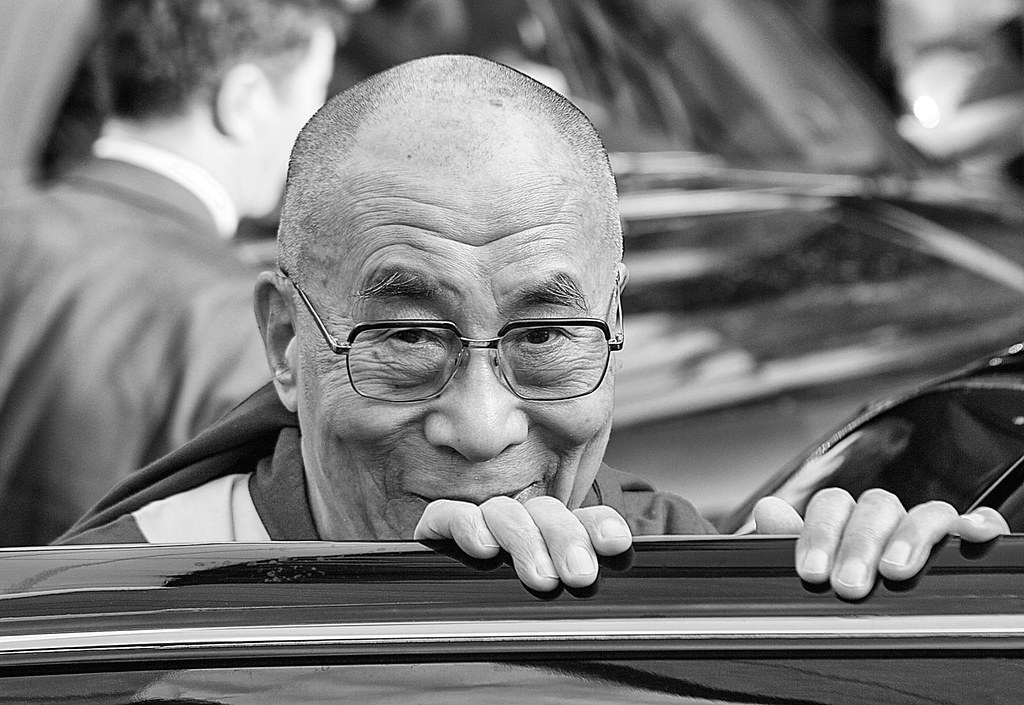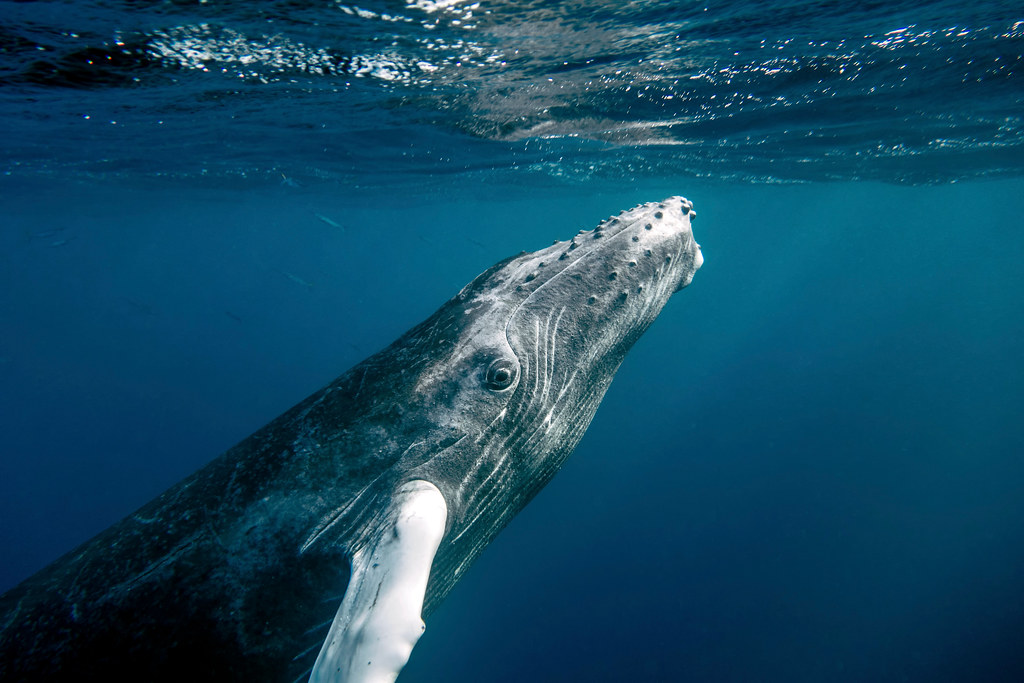If you ever find yourself at 70,000 feet in a U-2 spy plane and you experience explosive decompression of the cabin, you’ll be happy you’re wearing a protective a space suit and you paid attention in the training simulator on Earth when they taught you how to eject.
Flickr Recommended Photographer Christopher Michel described the “Chamber” where U-2 flight decompression training happens as a “large, reinforced steel tank with a U-2 seat.” A team of technicians and medical professionals stands outside while they pressurize the chamber to the equivalent U-2 cabin pressure.
“They then simulate a cabin breach by bringing the cabin altitude to 70,000 feet in an instant,” said Chris. A glass bottle filled with water in the chamber boils, showing you what would happen to your blood if you weren’t in your protective gear. “Quite an experience!”
Among many pursuits in business and investment in Silicon Valley, Michel is an extraordinary adventurer. Along with flying and taking photos from the U-2 plane — at the time of the flight, only the 10 people living in the International Space Station and a Chinese capsule were further from the planet’s surface — he has taken stunning images in Antarctica, Mt. Everest, The Korean DMZ, Cuba, Papua New Guinea, and many other locations. He also takes lovely portraits and captivates us with vivid street scenes around the world.
Chris recently participated in an interview with Flickr to explain how he shoots in extreme locations, what inspires his aesthetic, why he enjoys the Flickr community, and where he’s planning his next adventure (the North Pole, of course!).
How did you first get into photography?
After graduate school, a friend of mine gave me a camera for an upcoming cross-country trip from Boston to California. We stopped at Glacier National Park and I just started shooting – that was it. I loved it. That was 1998, and I haven’t looked back! That was millions of pictures ago!
What is your favorite place to photograph and why?
My favorite location in the world is Antarctica – a crystal desert, almost untouched by man. Antarctica is a beautiful and unforgiving landscape of blue ice, drifting icebergs, remote islands, whales & penguins! What’s not to adore.
I’ve been there four times. My last trip was shooting Emperor Penguins in Gould Bay, and explorers and scientists at the South Pole.
I love shooting people in extreme conditions and life in Antarctica is almost as extreme as it gets. It’s 30 below zero at the Pole in mid-summer, and only gets colder from there. The facilities at Scott-Amundsen Base South Pole Base resemble a moon station – humans need full life support (food, shelter, power) to survive. It makes for absolutely fascinating photography. Even the mundane is extraordinary.
What kind of training did you need to do to prepare for the U2 flight?
Getting a chance to fly in the U-2 Dragon Lady to the edge of space was one of the great thrills of my life. I’ll never forget looking through the helmet of my spacesuit into the blackness of space above and the curved blue Earth below. I was the 11th highest Earthling – only the astronauts at ISS and in the Chinese capsule were higher. The flight lasted two and a half hours and ended with a champagne toast in the cockpit. Thank you USAF!
I had to do about three days of training to prepare for the flight. There were medical exams, spacesuit fittings, survival training, cockpit familiarization, and decompression/ejection training. All of it was fascinating.
I’ve written more about the experience here: http://www.usni.org/u-2s-still-flying-high
I used to be a Naval Flight Officer in the Navy, flying aboard P-3C Orion’s. I’ve also trained in lots of other military aircraft. The U-2 is something completely different, primarily because the pilots wear full spacesuits. This requires a significant amount of pre and post-flight prep. Once in the suit, you need to be supplied oxygen and are transported to and from the plane in a special vehicle. The flight itself was very smooth and the landing, as always, tricky. The U-2 is considered one of the most difficult planes in the world to land – it essentially has to be stalled just above the runway.
You mentioned they taught you how do you survive explosive decompression? That sounds tense.
Before they let you fly in the U-2, they have you don your spacesuit for explosive decompression/ejection training in the “Chamber.” The chamber is essentially a large, reinforced steel tank with a U-2 seat. Once you’re “dressed” (an hour-long activity), they walk you into the chamber, strap into your seat, and seal you in (claustrophobics need not apply).
A team of 10 technicians, medical professionals, etc, stands outside while you wait patiently as they increase the chamber altitude to 12,000 feet (similar to the pressurized cabin of the U-2). They then simulate a cabin breach by bringing the cabin altitude to 70,000 feet in an instant. You hear a loud boom, the room mists, and your spacesuit inflates in response. Your arms are pushed up and out (the spacesuit is now providing proper pressure for your body).
A glass bottle filled with water is on a table in the chamber and the water begins to boil (simulating what would happen to your blood if you didn’t have a spacesuit). The technicians then announce “Eject, Eject Eject” as you pull your arms down and pull the ejection handle and switch to seat-supplied oxygen. Quite an experience!
What challenges did you face shooting from that cockpit?
Two big challenges: small cockpit and big spacesuit (wearing huge gloves!). It was hard to access the cameras and use them. There was also some ice on the cockpit windscreen.
In the selfie you took from the cockpit, is the camera mounted to the plane? How many cameras did you have?
I had mounted a GoPro on the dashboard of the U-2 and alternated taking external and internal shots. I brought 3 cameras – the Canon 5D Mark II, the Olympus EP3, and the GoPro. Interestingly enough, the Canon failed at altitude.
What or who influences your photos of people?
Street photography and portraits are my favorite kinds of pictures. I just love capturing people. Not surprisingly, Bresson’s work sets the standard. Few things are more enjoyable that capturing a great picture of a friend or a stranger and then giving them that photograph as a gift. It’s built the bonds of hundreds of friendships throughout the world. And these photos often have a life of their own,ending up as Facebook profile pictures, Wikipedia articles, websites, magazines, and books.
Portrait photography also has the added benefit of contributing to the historical record of people, experiences, companies, and eras. I work with many entrepreneurs in Silicon Valley and have been photographing them for over a decade. They’ve already changed, and these once “just-ok” photos are now historically important, both to them and to history. It’s a kind of digital alchemy.
Who has been your favorite subject to shoot and why?
Well, it would have to be His Holiness the Dalai Lama. I was given an opportunity to be his photographer for three days and spend hours of time with him in both very public and intimate settings. It was probably the most challenging shoot of my life. It was also one of the most rewarding. He really is who you would wish him to be: incredibly kind, gracious and compassionate. I was very blessed to have had that opportunity.
You shoot on a wide array of cameras and equipment – is there a preferred kit that you use?
Well, like a lot of photographers, I love gear.
I’ve shot an incredibly wide variety of cameras, from SLRs to medium formats to rangefinders. These days, my go-to kit is a Nikon SLR (D800E/D4) for nature, landscapes, and extremes, and the Leica M (or Sony A7s) with my 50mm Noctilux f/.95 for street and portraiture. I’ve also been enjoying the Fuji X-T1 as an SLR alternative.
Over the past couple years, I’ve become less enamored with SLRs. They’re big, the required lens kit weighs a ton, and the output seems mechanical. If I’m going someplace where I absolutely need incredibly high-resolution images, weatherproofing, fast autofocus, or long-lenses, I’ll take along the D800 or D4.
Otherwise, I’d prefer to bring the Fuji X-T1 and the Leica M (or Monochrom). I adore Leica glass, and the latest generation of the Leica M’s really works well. I prefer to shoot wide open, preferably at f1.4 or below.
When I photographed His Holiness the Dalai Lama conducting the Kalachakra Initiation ceremony in Ladakh, India, my kit was simple, elegant and effective: just the Leica M + 21mm, 35mm, 50mm, and 90mm lenses. In total, it weighed less than my Nikon and 24-70 lens!
If you’re not traveling explicitly for a shoot, what’s in your camera bag?
I carry a real camera everywhere – to dinner, to get a coffee, on business trips, etc. I’m usually packing a Leica M plus the Noctilux. Recently, however, I’ve been using the Sony A7S and the Noctilux (with a Novoflex adapter). The low-light capability of that camera is really amazing. If I need a pocket camera, I’ll bring along the RX100 III. I keep my kit in a small, beautiful leather bag made by Ona.
Your photographic style is very broad. What led you to have so many interests in photography?
My first passion is to take photos of people engaging in the extremes of life, from a cremation ceremony in rural Myanmar to mountain climbers in Antarctica to pilots on the deck of an aircraft carrier – humans showing incredible focus.
But I also shoot everything. I shoot landscapes, street photography, models, food, macro, nature, drones, travel catalogs, underwater, etc. I have an insatiable curiosity about life. I also love to travel, learn, and engage with people of all walks of life. So, I’ll try anything, and if I see a shot, I’ll try and take it.
Why should we create barriers around creativity? Perhaps it makes me harder to define as a photographer, but I care more about doing great work and having fun than about my brand. I’ll let the work speak for itself.
What’s the most challenging aspect of photographing in extreme locations?
It’s probably getting there! Everest, Antarctica, Tibet, Kazakhstan, Papua New Guinea, etc are far away. So, showing up is half the battle. Gear can also be a challenge: keeping battery packs charged without access to power, dealing with equipment failures, etc. Generally, though, the hard part is over once I’m there and shooting.
The hardest part of “shooting” however is having the courage to engage with people to take their picture. It’s culturally difficult to interrupt strangers to ask to take their photos, but so worth it.
What’s the one shot you want that you haven’t yet captured?
One shot? There are thousands I long for! I’m still hopeful that one day I’ll take that perfect picture…the ONE that everyone sees and says, “yes, that’s a Chris Michel.” Until then, I’ll just keep shooting and having fun.
What’s next in your travels?
The North Pole. Of course.
What do you like about Flickr and what have you learned from the Flickr community?
I’ve been a Flickr member since 2004. It’s an essential part of my workflow. It’s also the easiest way for me to find photos from my archive. Tagging, organizing, archiving and sharing is made so easy.
It’s also one of the primary ways people find my photos. I make them available via Creative Commons licenses and they are used almost every day in publications, Wikipedia, etc. I’ve also benefited a great deal from the strong support of the Flickr community! I can say without reservation, “I love Flickr.” Go Flickr and thank you!








